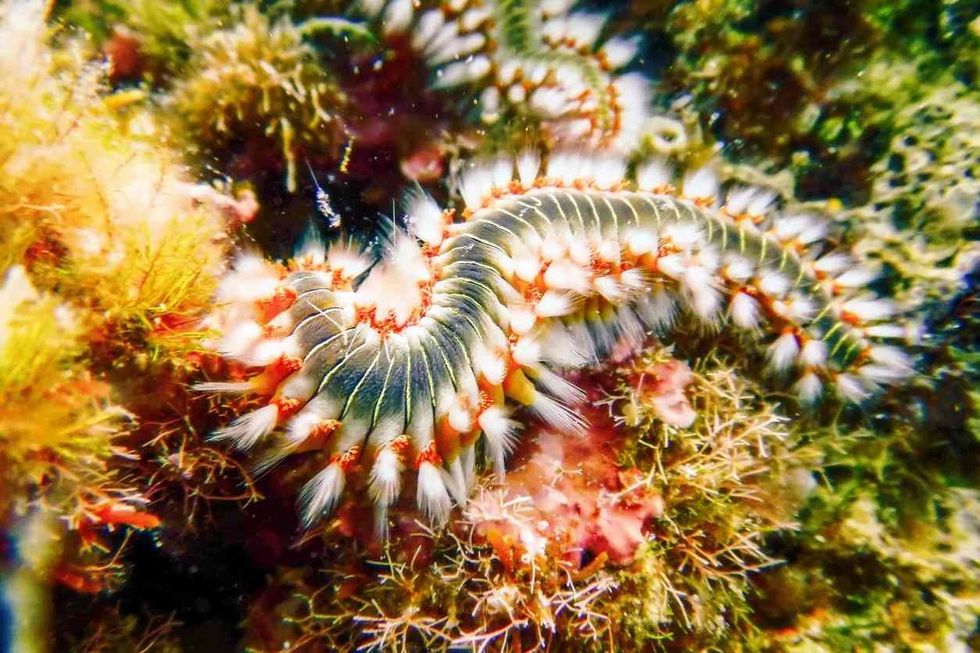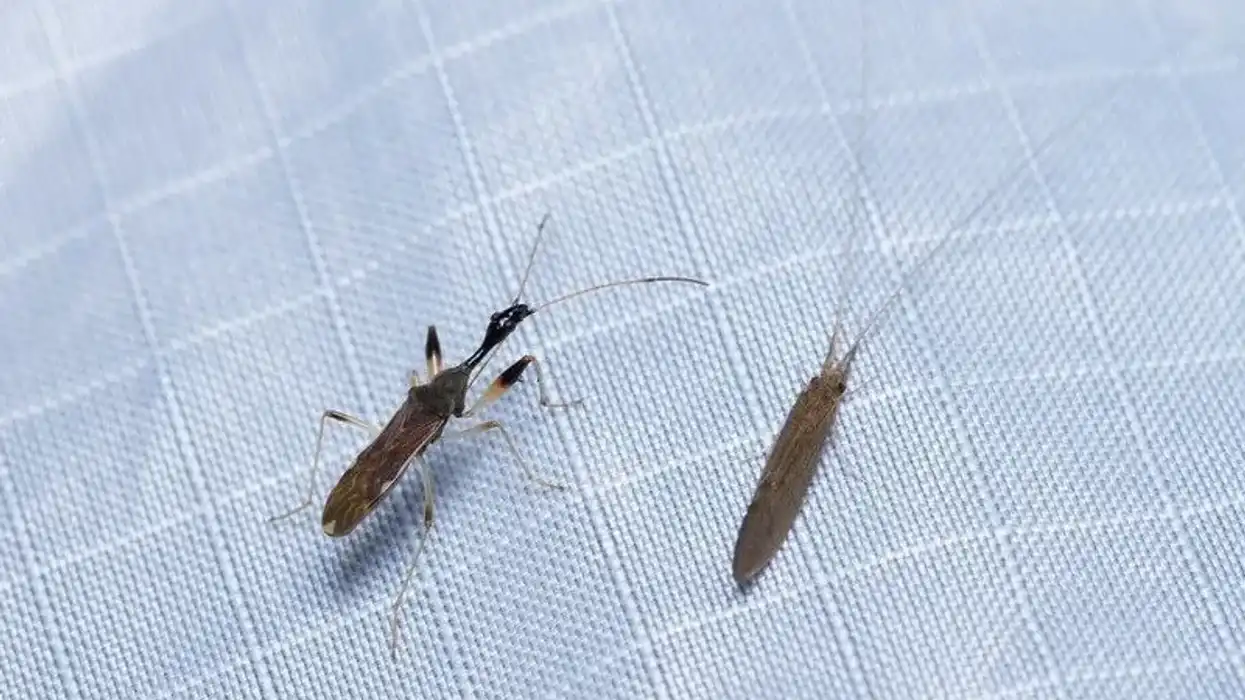The Bearded Fireworm (Hermodice carunculata) gets its name from the word for the sensory organ present in this worm caruncle. It is mostly found in the Gulf of Mexico, Atlantic ocean, Caribbean, Mediterranean, and Red seas.
Its habitat includes stones in rocky areas or coral beneath the stones or in mud. They are known to emit a glow during the process of mating. These animals are carnivores and the Bearded Fireworm diet includes marine life including corals, anemones, and crustaceans.
They reproduce both sexually and asexually. The color of their body ranges from green, yellow, red, and white with a pearly glow. They are segmented and flattened in appearance and have bristles and branched gills.
A Bearded Fireworm sting can be painful and its spines could be removed with sticky tape. This species is quite fascinating to learn about!
For more animal facts, visit flatworms facts and sea snake facts.
Bearded Fireworm Interesting Facts
What type of animal is a Bearded Fireworm?
Bearded Fireworm is an active type of bristleworm.
What class of animal do Bearded Fireworms belong to?
The Bearded Fireworm belongs to the invertebrate class of animals.
How many Bearded Fireworms are there in the world?
There is no specific number reported for the number of these worms in the world and this fireworm is not listed in the International Union for Conservation of Nature (IUCN).
Where do Bearded Fireworms live?
The Bearded Fireworm is found in marine environments like coral reefs, rocks, sand, mud, and in clear shallow waters. They are found in the Atlantic Ocean, Mediterranean Sea, Caribbean, Gulf of Mexico, and Red Sea.
What is a Bearded Fireworm's habitat?
The Bearded Fireworm live in corals beneath stones or in mud and reefs and are generally found in rocky areas, sands, and muds in clear shallow waters. They are found in depths of up to 150 m and near-surface during wreckage.
Who do Bearded Fireworms live with?
While they generally live alone, there have been found groups when these fireworms are feeding.
How long do Bearded Fireworms live?
The lifespan of the fireworm is unknown.
How do they reproduce?
The Bearded Fireworm (Hermodice carunculata) is known to reproduce both sexually and asexually. In asexual reproduction, the fireworms go through fragmentation, and their body separates into fragments and gets regenerated by growing head and tail and developing into new individuals.
While in sexual reproduction, females produce pheromones attracting the males.
The breeding happens two to five days after the full moon when the eggs are laid. Most eggs are planktonic, while some are retained in tubes or burrowed in jelly masses or egg brooders, the larvae hatch and move into the sea and continue their life.
What is their conservation status?
The conservation status of this fireworm is unknown and is not listed in the International Union for Conservation of Nature (IUCN).
Bearded Fireworm Fun Facts
What do Bearded Fireworms look like?
This fireworm looks similar to the centipede but has flattened bodies with a range of colors like green, yellow, white, and red with a glow. They are protected by a cuticle which is divided into almost 60-150 segments by white streaks.
The segments have pricking white bristles and branched gills and parapodia which helps in locomotion along the sides. These bristles are fragile, hollow, and venom-filled and thus, can easily break. The anterior part has a red appendage called the caruncle.
This is a chemo-sensory organ that is related to smells. The mouth underside of this worm is located on the segment behind the head which has eyes and other sensory organs.
How cute are they?
While it is considered cute and beautiful due to its range of colors and size, they are 'do not touch' cute as it can be harmful when touched.
How do they communicate?
Not much is known about the communication of these species, but it is known that they identify prey using the olfactory organ caruncle. They sometimes form groups during feeding and when threatened use their bristles to defend or protect themselves.
How big are Bearded Fireworms?
Usually growing 4-6 in (102-154 mm) on average, some also species grow up to 12 in (305 mm). They are like any worm in size.
How fast can Bearded Fireworms move?
Although these worms have well-developed muscles and swim and crawl with their parapodia, these worms are considered to be one slow creature and are not harmful until touched.
How much do Bearded Fireworms weigh?
The weight of these worms is unknown.
What are their male and female names of the species?
There are no specific names for males and females of the species.
What would you call a baby Bearded Fireworm?
There is no specific name for a baby fireworm, although when the eggs develop it is called a larva.
What do they eat?
These worms are greedy predators and feed on marine life like hard and soft corals, anemones, crustaceans, and other worms and invertebrates. These worms also scavenge on squids, shrimps, krill, clams, and other dead animals found at the end of the ocean.
Are they harmful?
While they are considered to be one slow creature, it could prove to be painful when a person comes in contact with the worm.
As it has venom-filled bristles, when it penetrates human skin, it injects it with a strong neurotoxin which could lead to irritation of the skin and a burning sensation around the area of contact. This sting could also result in a feeling of dizziness or nausea.
The burning sensation and irritation can stay for a few hours and pain can be felt around the contact area for a longer time.
Would they make a good pet?
While these worms are great for keeping the tank or their habitat clean as they scavenge on dead animals or any other rotting things and move into places such as stones in rocky places and crevices where other marine animals can not, it should be ensured that human skin should not touch this worm as it can cause pain in the area of contact of the skin.
This worm has the tendency to sting with its venom-filled bristles when it feels threatened and can also cause damage to other marine life in the tank that includes fish and coral.
Did you know...
Hermodice carunculata is known to be bioluminescence during sexual activity.
If accidentally the skin comes in contact with its bristles, apply and remove adhesive tape to get rid of the spines as it is important to first remove the hair or spines that are transparent and with tape, it becomes an easy process. Rubbing alcohol and vinegar can help the painful burning sensation and irritation.
They are highly active and mobile during the night time and inactive during the day and also are fluorescent at night. These worms can engulf the tip of the coral and remove the coral tissue within 5-10 minutes.
The bristles of Hermodice carunculata are small but brittle and sharp like a porcupine and larger worms have bristles and also jaws with which they can bite. They are also capable of piercing human skin.
What is responsible for the glow in a bearded fireworm?
While the reason behind the glow in this animal is not known in detail, it is believed that this worm and other invertebrates that also possess a similar glow is due to the presence of luciferase and other genetic differences as it mostly occurs when it comes to the surface to mate.
Some other enzymes have also been found over which research is still going on.
What is the phylum of a bearded fireworm?
The Bearded Fireworm phylum is Annelid because its body is segmented.
Here at Kidadl, we have carefully created lots of interesting family-friendly animal facts for everyone to discover! Learn more about some other arthropods including giant African millipede, or centipede.
You can even occupy yourself at home by drawing one on our Bearded Fireworm coloring pages.
The second image is by Diego Delso CC BY-SA delso.photo









